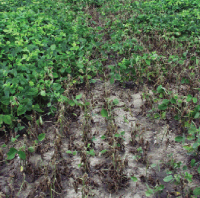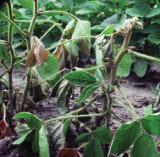
Features
Agronomy
Diseases
Phytophthora a concern for several reasons
Dry conditions have kept it low recently.
September 30, 2008 By Ralph Pearce
Dry conditions have kept it low recently.
Phytophthora root rot has not been a significant problem in the past few years, thanks in part to the relatively dry conditions in soybean fields in Ontario and western Quebec. Soybean cyst nematode and bean leaf beetles have done much to upstage phytophthora, as well as pythium.
 |
| Phytophthora pathogens are overcoming some of the standard resistance genes, meaning a return to a normal spring could see a return of the disease in 2008. |
However, if there is such a thing as a normal spring and growing season in 2008, the two diseases could be seen in higher concentrations, particularly with the findings of a recent research survey of north central Ohio and into Ontario. That survey has found that the most commonly deployed resistance genes have been compromised to the extent that some genes are still effective while some are not.
“We would have expected that based on the preliminary data that we had, but then that means the partial resistance component is really important for
growers to pay attention to,” says Dr. Anne Dorrance of Ohio State University. “Along with that, we evaluated seed treatments and the trend indicates that when it rains shortly after planting, growers will receive the economic benefit from putting on that seed treatment.”
According to Dorrance, that trend has been seen already by Ontario and Ohio growers who farm on heavier clay soils. A part of that trend that she finds
noteworthy is the lack of specificity that some growers tend to use when
discussing seed treatments. “There are all kinds of seed treatments, and just because a grower applies Poncho does not mean he’s controlling his pythium and phytophthora,” she explains. She cites CruiserMaxx as an example of a fungicide and insecticide treatment on which growers are increasingly reliant. “But growers need the metalaxyl (metalaxyl-M) portion of it to control their pythium and phytophthora. I’m still surprised that growers are mixing the insecticides and fungicides, and calling them all seed treatments.”
Resistance a reality
First and foremost however, concern with phytophthora is that resistance to the Rps 1k and Rps 1c genes, which have been the most dominant resistance genes for several years, is developing, although not to the extent of making the genes obsolete. “Growers are still going to get control because not every isolate has adapted and I think that’s always going to be the case,” reasons Dorrance. “But the fact of the matter is these genes are not going to give you that 100 percent control like they were doing beforehand. So it’s really important that growers have that partial or background resistance component to go back up against that, so they don’t see the stem rot phase and they don’t have plants going down through the season.”
In general terms, phytophthora is not affected by rotation or other agronomic practices; it is more heavily influenced by weather conditions and their impact on the soil. For Albert Tenuta, field crops pathologist with the Ontario Ministry of Agriculture, Food and Rural Affairs, odds are favourable that a normal, wet-to-start planting season is going to return. “At some point, we will have a normal spring and with that comes wet spring conditions,” says Tenuta. “Growers are also pushing planting dates earlier and with that, you have the potential for more of the soybean crop hitting a wet spell.”
 |
| A soybean plant in the early stages of dieback as the result of phytophthora root rot provides a clear image of why this disease is so important to breeders and pathologists. |
One cautionary note Tenuta adds is for growers to guard against the myth that once the crop is out of the ground and growing, the threat of phytophthora is gone. “That’s not quite the case,” he says. “If you have saturated soil conditions, a one or two inch rain in July is enough to start the infection process. If those conditions are favourable at any time, the plants can be susceptible. Phytophthora as well as pythium are unique pathogens in that they produce mobile spores (zoospores) which swim in the water film between soil particles to locate and infect soybean roots.”
Tolerance can help
Although there are more races developing, Tenuta reminds growers that there are a lot of varieties with good levels of tolerance, which is a benefit since it is not race specific, meaning it protects or compensates for injury against any race of phytophthora. “The problem though, is there are some varieties that aren’t as good on the tolerance side, and if you planted a variety in which resistance is broken by a new race or races, significant damage can occur,” he says.
Tenuta and Dr. Terry Anderson of Agriculture and Agri-Food Canada in Harrow, Ontario, are working with their north central US soybean pathologist colleagues, including Dorrance, to determine the different P. sojae races across the northern US soybean production areas, as well as Ontario.
“We’re seeing races that can take down the Rps 1c and Rps 1k genes,” explains Tenuta. “Fortunately, the breeders have done a great job incorporating the 1c and 1k resistance genes, but they’ve also kept up tolerance levels in most cases. If it wasn’t for enhanced tolerance levels in today’s varieties, the changes in phytophthora races would have caused significantly more damage like they did 15 to 30 years ago when tolerances, deemed a ‘back-up’ strategy, were lower or
not effective.”
Resistance to the 1c and 1k genes is similar to what occurred with the last standard for resistance, the Rps 1a gene, which was the first effective broad use resistance gene utilized in soybean production in North America. Tenuta says that gene survived for 20 years or more but now, 95 to 99 percent of phytophthora races in Ontario and the north central US can by-pass that source of resistance.
However, there is a sense of optimism that creeps into a story like this; Tenuta treats the discovery of SCN east of Toronto as a good news story because now that it has been found, it can be managed. And Dorrance echoes that sentiment with respect to phytophthora. “Knowing that it’s here, knowing that the genes aren’t going to be totally effective, growers need to do a little bit better job of choosing the best varieties to get the total resistance package,” she advises. “Then use a seed treatment on those fields with a lot of clay or have drainage problems, and then they won’t see those losses.”